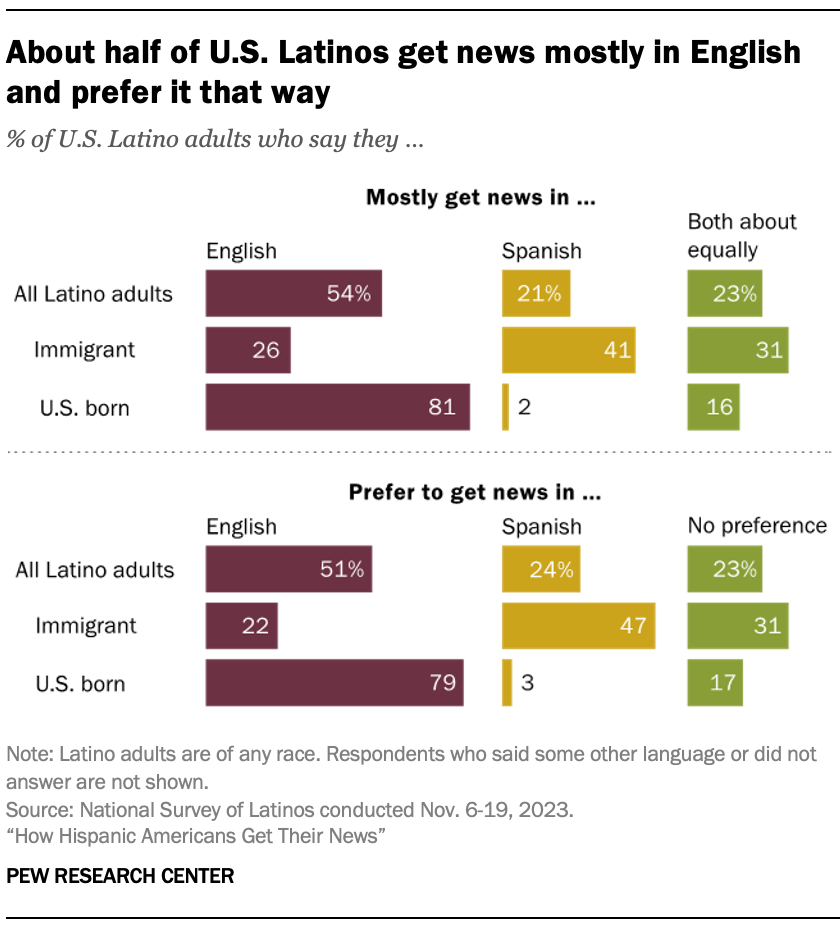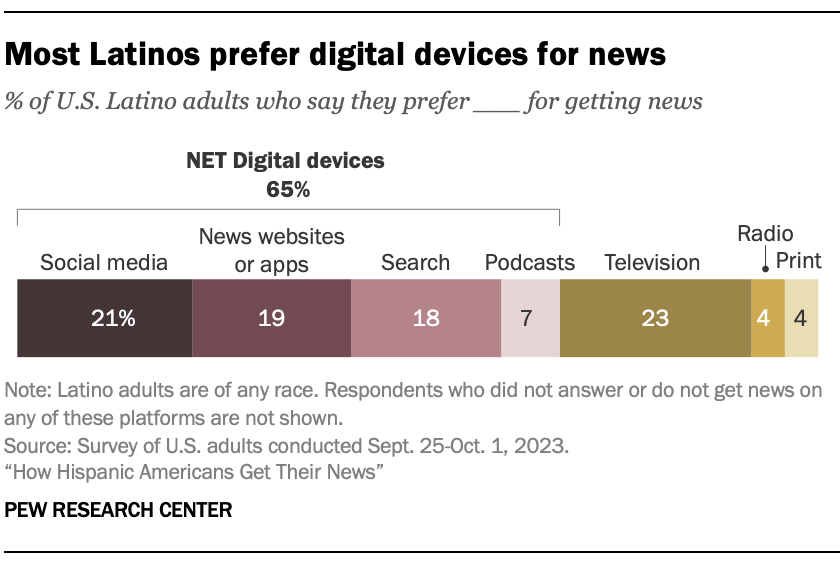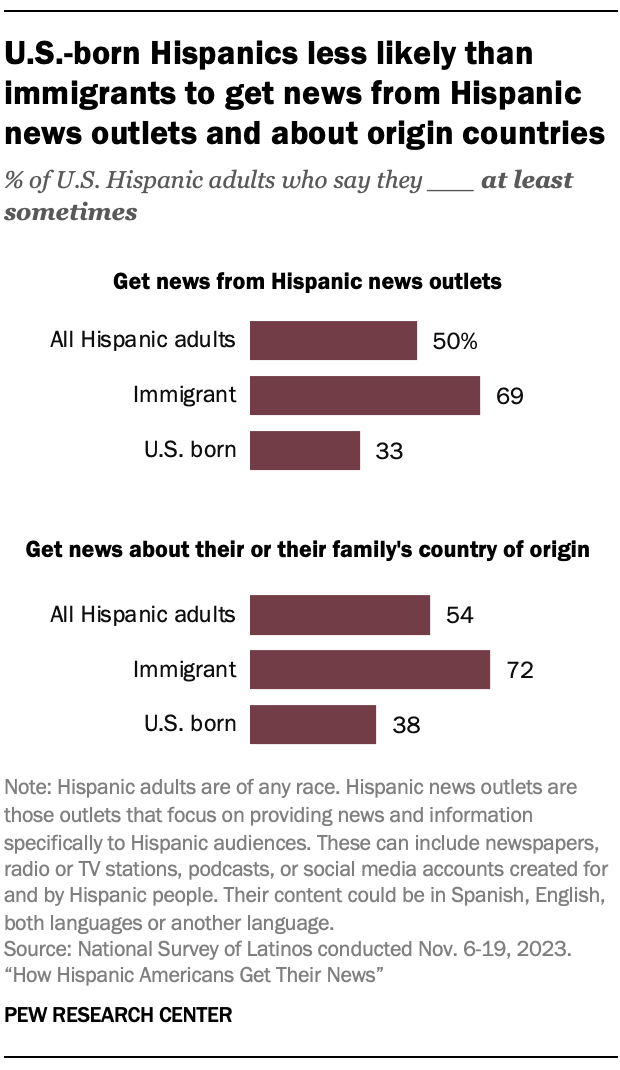U.S.-born Latinos overwhelmingly prefer to get their news in English; about half of immigrant Latinos prefer it in Spanish

Pew Research Center conducted this study to understand Hispanic Americans’ habits around news and information, including the languages in which they consume news and their engagement with Hispanic media outlets.
Most of the questions in this report are from Pew Research Center’s 2023 National Survey of Latinos, a survey of 5,078 U.S. Hispanic adults conducted Nov. 6-19, 2023. This includes 1,524 Hispanic adults on the Center’s American Trends Panel (ATP) and 3,554 Hispanic adults on Ipsos’ KnowledgePanel. Respondents on both panels are recruited through national, random sampling of residential addresses. Recruiting panelists by phone or mail ensures that nearly all U.S. adults have a chance of selection. This gives us confidence that any sample can represent the whole population, or in this case the whole U.S. Hispanic population. (For more information, watch our Methods 101 explainer on random sampling.)
To further ensure the survey reflects a balanced cross-section of the nation’s Hispanic adults, the data is weighted to match the U.S. Hispanic adult population by age, gender, education, nativity, Hispanic origin group and other categories. Read more about the ATP’s methodology. Refer to the topline for the questions used for our National Survey of Latinos, along with responses, and to methodology for more details.
The questions about how often people get news from various platforms, which platforms they prefer for getting news, and which social media sites people get news from are from an ATP survey of 8,842 U.S. adults, including 1,193 Hispanic adults, conducted Sept. 25-Oct. 1, 2023. Refer to the topline for the questions used for this survey, along with responses, and to the methodology for more details.
Pew Research Center is a subsidiary of The Pew Charitable Trusts, its primary funder. This is the latest report in Pew Research Center’s ongoing investigation of the state of news, information and journalism in the digital age, a research program funded by The Pew Charitable Trusts, with generous support from the John S. and James L. Knight Foundation.
The terms Hispanic and Latino are used interchangeably in this report.
Hispanic/Latino Americans, Hispanic/Latino adults, and Hispanics/Latinos are used interchangeably in this report to refer to survey respondents who self-identify as Hispanic or Latino in the United States. They include those who say their race is White, Black, Asian or some other race and those who identify as multiracial. Hispanic/Latino Americans live in the U.S. but are not necessarily U.S. citizens.
U.S. born refers to people born in the 50 states or the District of Columbia.
Immigrant refers to people born outside the 50 states or D.C. For the purposes of this report, immigrants include those born in Puerto Rico or another U.S. territory. Although individuals born in Puerto Rico are U.S. citizens by birth, they are grouped with immigrant respondents because they were born into a Spanish-dominant culture and because on many points their attitudes, views and beliefs more closely resemble those of Hispanics born outside the U.S. than Hispanics born in the 50 states or D.C., and even U.S.-born Hispanics who identify as being of Puerto Rican origin.
Second generation refers to people born in the 50 states or D.C. who have at least one parent born in a different country, Puerto Rico or another U.S. territory.
Third generation or higher refers to people born in the 50 states or D.C. who have two parents born in the 50 states or D.C.
Language dominance is a composite measure based on self-described assessments of speaking and reading abilities. Spanish-dominant people are more proficient in Spanish than in English (i.e., they speak and read Spanish “very well” or “pretty well” but rate their English ability lower). Bilingual refers to people who are proficient in both English and Spanish. English-dominant people are more proficient in English than in Spanish.
“Middle income” is defined here as two-thirds to double the median annual family income for panelists on the American Trends Panel. “Lower income” falls below that range; “upper income” falls above it. Refer to the methodology for more details.
Hispanic news outlets are those outlets that focus on providing news and information specifically to Hispanic audiences. These can include newspapers, radio or TV stations, podcasts, or social media accounts created for and by Hispanic people. Their content could be in Spanish, English, both languages or another language.
Country of origin refers to the country that survey respondents, their parents or their Hispanic ancestors came from.

Just over half of U.S. Hispanic adults (54%) get their news mostly in English – far higher than the share who get their news mostly in Spanish (21%). About a quarter of Hispanic Americans (23%) say they consume news in both languages about equally.
There is an almost identical pattern on the question of preferred language for news: 51% prefer to get their news in English, 24% prefer Spanish and 23% say they do not have a preference.
But a new Pew Research Center survey of adults who identify as Hispanic or Latino finds major differences in news consumption habits between U.S.-born Hispanics and those who immigrated from other countries.
While U.S.-born Latinos overwhelmingly get their news in English, and prefer it in English, those born outside the United States have much more varied habits: 41% get their news mostly in Spanish, 26% get it primarily in English and 31% do both about equally. Similarly, 47% of Latino immigrants prefer to get their news in Spanish, while 22% prefer English and 31% do not express a preference.
Among Latino immigrants, those who have spent more years in the U.S. are less inclined than more recent arrivals to get news in Spanish, and more inclined to get it in English. There is little difference in the shares who get news in both languages about equally.
Jump to more information on the languages in which U.S. Latinos consume news.
We asked these questions to better understand how a group that makes up nearly one-in-five Americans stays informed, especially as its demographics and use of Spanish continue to change. Immigrants are declining as a share of all U.S. Hispanics, and the share of Hispanics who speak Spanish at home has also dropped – even though the number of Hispanics who speak Spanish at home has increased due to overall growth in the Hispanic population.
Other key findings about Hispanics’ news consumption include:
Most Latino adults prefer digital devices for news

Latinos get their news from a variety of sources, but most say they prefer to use digital devices over other platforms. Nearly nine-in-ten (87%) say they get news from digital devices at least sometimes, and 65% say they prefer this form of news over TV, radio or print. Digital devices have become an increasingly common source for news among Latinos – and among Americans overall – in recent decades, a shift driven by the rise of the internet.
Latinos are more likely than White Americans (55%) and Black Americans (50%) to prefer getting news from digital devices. Latinos also are more likely than White and Black adults to get news from social media, at least in part because Latino adults tend to be younger than other groups, and young adults are more inclined to use social media for news.
Nearly three-quarters of Latino adults under 50 (73%) prefer to get their news on digital devices, including 27% who prefer social media specifically.
Jump to more information on the platforms where U.S. Latinos get news.
Attention to news is declining among U.S. Latinos

About one-in-five Latino adults (22%) say they follow the news all or most of the time, while an additional 36% follow the news some of the time. The share of Latinos who follow the news all or most of the time has fluctuated in recent years but has dropped by 9 percentage points between 2020 (31%) and 2023 (22%), similar to a pattern seen across the general U.S. public.
In recent years, Hispanic Americans have followed the news less closely than Black and White Americans. Again, the high share of young adults within the Hispanic population plays a role, because young people are less likely to follow the news closely. Among Hispanic adults ages 18 to 29, just 10% say they follow the news all or most of the time – far below the share of Hispanics ages 65 and older who do so (44%).
Jump to more information on U.S. Hispanics’ news consumption habits.
Half of Hispanic adults get news from Hispanic news outlets

Half of U.S. Hispanic adults say they at least sometimes get news from Hispanic news outlets – those that specifically cater to Hispanic audiences. This includes 21% who say they do this extremely or very often. Just over half of Hispanics (54%) get news about their or their family’s country of origin at least sometimes, including 24% who do this often.
Hispanic immigrants are much more likely than U.S.-born Hispanics to get news from Hispanic outlets and about their origin country. In both cases, about seven-in-ten immigrants say they at least sometimes get these types of news: 69% get news from Hispanic outlets and 72% get news about their country of origin. Among Hispanic adults who were born in the U.S., 33% at least sometimes get news from Hispanic outlets, and 38% get news about their family’s country of origin.
There are further differences among U.S.-born Hispanics: Those whose parents were also born in the U.S. are even less likely than those with one or more immigrant parent to get these types of news.


